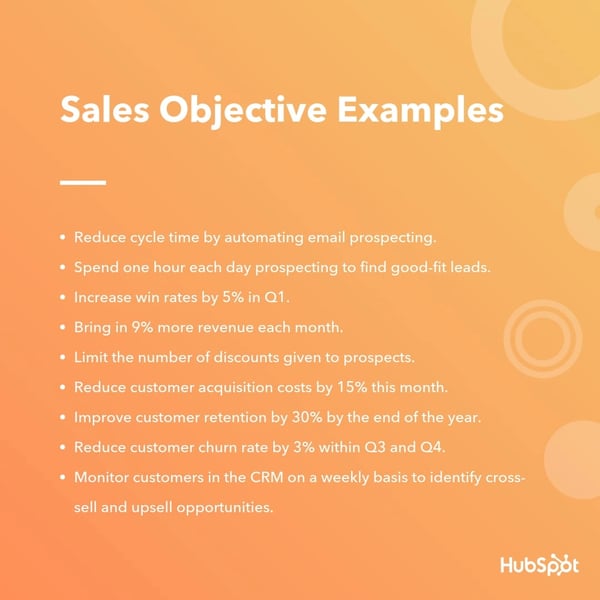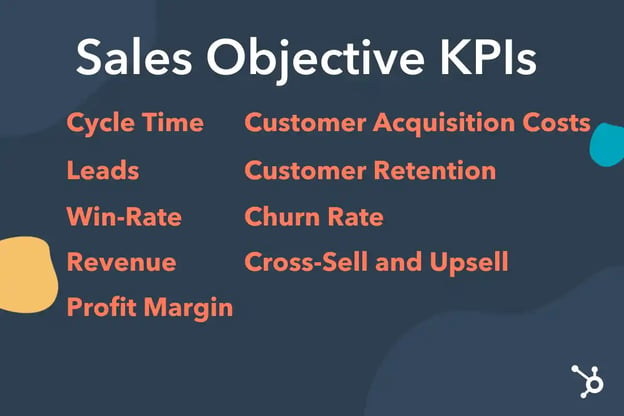What are sales objectives?
Sales objectives are used by management to supplement the vision and goals they have set for the company and sales department. The sales objectives outline the specific, measurable actions each employee must take to achieve the overall goal.
For example, let's say the sales team has a goal of increasing revenue over the next six months. To reach this goal, each salesperson's objective is to increase the amount of revenue they bring each month by 2%.
Both sales goals and objectives are discussed and set by the leadership team and communicated to the entire sales team, often with a sales plan. For sales objectives to be effective, SMART goals are often used to provide. These sales goals are:
- Specific
- Measurable
- Attainable
- Relevant
- Time-bound
Sales metrics are used to monitor the progress and evaluate the success of the sales organization as they carry out the sales objectives.
Inside Sales Objectives
As you can imagine, inside sales objectives help guide inside sales efforts — meaning they pertain primarily to metrics and KPIs that cover sales activities that are conducted remotely. But now that the line between inside and outside sales is becoming blurrier, most inside sales objectives apply to outside sales as well.
Let's take a look at what some of those objectives might look like.

Types of Sales Objectives
A business' sale objectives often fall within one of the following categories, but objectives can vary from company to company.
- Cycle time
- Leads
- Win rate
- Revenue
- Profit margins
- Customer acquisition costs
- Customer retention
- Churn rate
- Cross-sell and upsell

Let's check out what sales objectives might look like in practice.
When setting sales objectives for your team, remember to keep the long-term goal in mind. Now, we'll take a look at some sales objective examples and the goals that are driving them.
Let's dive in.
1. Reduce cycle time by automating email prospecting.
Sales Objective Type: Cycle Time
Reducing cycle time helps the sales team reach its goal of closing deals quicker. Sales orgs often run into hitches by wasting their SDRs' time with menial, time-consuming tasks — including writing repetitive prospecting emails.
If you were interested in making good on this sales objective, you would probably look into email automation resources that can streamline these responsibilities without having reps come as too robotic or impersonal in their outreach.
2. Spend one hour each day prospecting to find good-fit leads.
Sales Objective Type: Leads
The goal is to increase the number of high-quality leads generated by the sales team. With more leads, there's a higher likelihood of closing more deals and achieving more revenue.
This particular objective is relatively self-explanatory. If you wanted to have members or your org spend one hour each day prospecting to find good-fit leads, you would encourage them to do exactly that. Allocate time on your team's schedule specifically dedicated to this objective.
This example is more process-oriented than it is results-oriented. So when you pursue objectives like this, you simply adjust your process and see where those changes take you.
3. Increase win rates by 5% in Q1.
Sales Objective Type: Win Rate
Win rate is a key indicator in the success of a sales team or individual contributor: the more deals won, the more revenue generated for the company.
Improving win rate is a bit more complicated than the two objectives listed above. Pursuing this sales objective will take a fair amount of tinkering and trial-and-error. There's no definitive, "adjust this, and see that" solution here.
You'd likely need to conduct a thorough analysis of individual reps' performances to expose the potential cracks in your operations that might be dragging win-rate down. Once you've identified those weaker points, you'd want to try offering more specialized, attentive training for salespeople that might be having trouble.
You would also try pressing your reps to involve decision-makers in sales as early as possible. That way, you can weed out deals that don't have real potential earlier on in the sales process.
Again, there's no guarantee that the cursory overview of solutions I just laid out will automatically improve win-rate. But if you're interested in pursuing a sales objective, it's going to start with thorough analysis, involve actionable training and advice, and take some strides to optimize your sales process's efficiency.
4. Bring in 9% more revenue each month.
Sales Objective Type: Revenue
This objective can be set for either an individual salesperson or a sales team to reach the goal of increasing the amount of revenue they bring in. More revenue can be often achieved by increasing the transaction size of each customer or the number of customers.
But improving revenue is similar to improving win-rate in that there's no clear-cut path to achieving this objective. It's going to involve taking an involved look at how individual reps are performing as well as a holistic overview of how your sales process is functioning.
Ideally, you'll be able to pin down performance gaps that might be undermining your ability to generate the revenue figures you'd like to see. Bridging those gaps might mean conducting more extensive sales training, investing in new sales technology, incorporating a new sales methodology, or doing anything else that might inspire your reps and meaningfully impact your sales process.
5. Limit the number of discounts given to prospects.
Sales Objective Type: Profit Margins
If the leadership team's goal is to increase profit margins, there are a few objectives they can pursue — including limiting the number of discounts prospects are offered.
Pursuing this objective is pretty straightforward. As I said, leadership can cap the number of discounts their reps are allowed to offer prospects each month — or they can flat-out stop allowing salespeople to offer discounts at all.
Beyond limiting discounts, sales leadership can take other strides to increase profit margins. In some cases, it might help to either increase prices or adjust pricing structures by offering bundles at varying price points.
6. Reduce customer acquisition costs by 15% this month.
Sales Objective Type: Customer Acquisition Costs
The broader goal is to reduce the amount it costs a company to acquire new customers. Customer acquisition cost is one of the telltale metrics behind your company's efficiency — involving contributions from both sales and marketing.
One way your sales department can help achieve this objective is by identifying where the most money is spent throughout your sales process. If you can tell where your sales efforts are the least cost-effective, you can try some quick fixes that might reduce costs at those points.
But as I mentioned, this objective isn't specific to your sales org. Customer acquisition costs lean heavily on how your marketing department is functioning.
If you were to pursue a goal like this, you'd likely need to thoroughly communicate across departments, better align your sales and marketing efforts, and go from there.
7. Improve customer retention by 30% by the end of the year.
Sales Objective Type: Customer Retention
Once you've sold to prospects and they converted to customers, the ultimate goal is to retain them. After all, retaining customers is more cost-effective than acquiring them.
Successfully executing this objective hinges on your ability to create and sustain an exceptional customer experience. That means taking actions like staying in touch with customers after they've purchased, letting them know you're still keeping them top of mind, and working to resolve their issues with your product or service as they raise them.
Incentives like loyalty programs can also be a big help. And like the previous point, nailing this objective extends beyond your sales org. Your customer service and customer success departments need to be active, attentive, and enthusiastic to help you maximize your customer retention potential.
8. Reduce customer churn rate by 3% within Q3 and Q4.
Sales Objective Type: Churn Rate
Churn rate — the rate at which your customers terminate their relationships with your company — is a key metric that can shape practical, meaningful sales objectives.
In a lot of ways, reducing customer churn is an extension of improving customer retention, so you'd want to take similar actions to the ones specified above. Keep in touch with customers. Position yourself as a trustworthy advisor that can address their concerns with your product or service, and let them know you care.
High customer churn can also be the byproduct of selling to poor-fit prospects. If your research and analysis indicate that that's the case, it might be time to reevaluate your lead qualification tactics.
9. Monitor customers in the CRM on a weekly basis to identify cross-sell and upsell opportunities.
Sales Objective Type: Cross-Sell and Upsell
If your goal is to increase the amount of cross-sells and upsells, a CRM database can help you identify the customers who have checked out a product page or requested a demo for a new feature. Setting the objective for salespeople to regularly check the CRM will identify these opportunities.
Like the second one on this list, this objective is much more process-oriented than it is results-oriented. Your ability to achieve it rests on you guiding your sales team to take the actions this objective lays out.
With well-crafted sales objectives, your sales team will have a clear direction for achieving their goals.
Sales Goals
.png?width=112&height=112&name=Image%20Hackathon%20%E2%80%93%20Square%20(14).png)


![How to Score Deals in the Final Quarter [Data & Expert Backed Tips]](https://53.fs1.hubspotusercontent-na1.net/hubfs/53/q4-sales.webp)
![Creating Sales Goals as a Sales Manager [Expert Tips & 11 Examples]](https://53.fs1.hubspotusercontent-na1.net/hubfs/53/Manager%20Goals.jpg)


![How to Hit Your Sales Quota Every Month [Essential Guide]](https://53.fs1.hubspotusercontent-na1.net/hubfs/53/585_How-to-Hit-Your-Sales-Quota.png)

